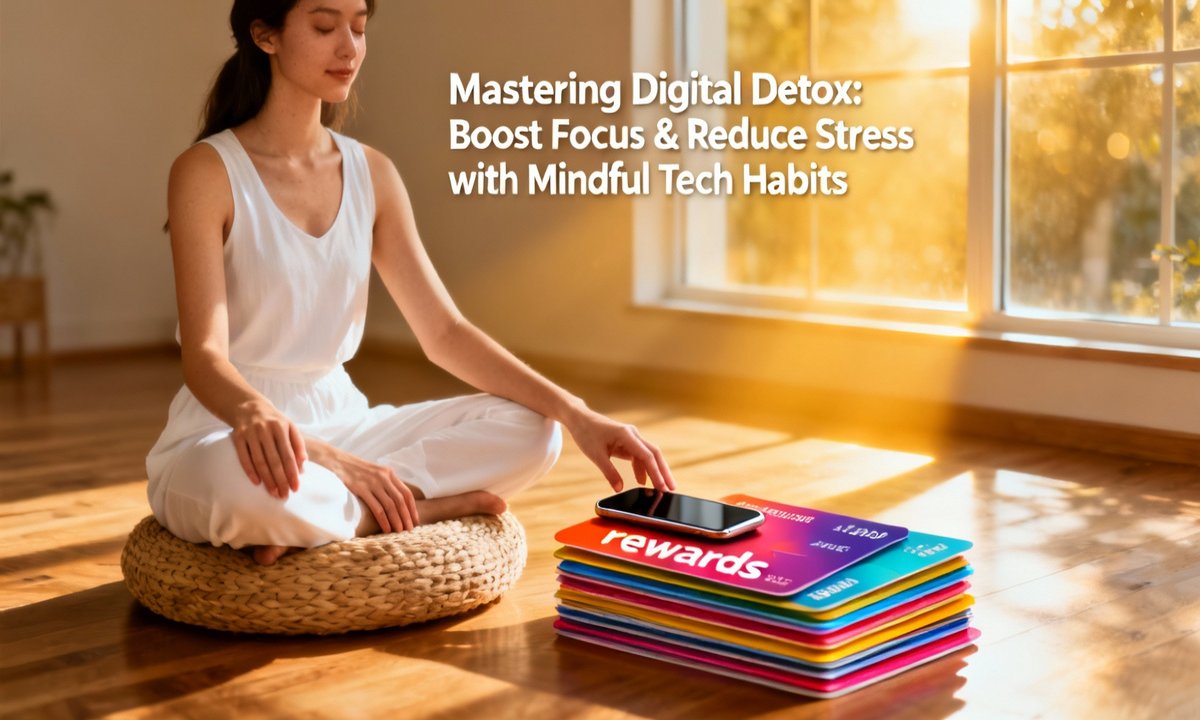In our increasingly connected world, the concept of a digital detox is moving beyond a simple trend to become a vital element of personal well-being. Many individuals are now seeking effective strategies to manage screen time, aiming to reduce stress and enhance their ability to focus daily. This guide explores why mindful tech habits are not just beneficial, but a critical life skill for everyone.
The Impact of Constant Connectivity
The continuous demand for digital engagement often takes a significant toll on both mental and physical health. Research indicates a notable increase in conditions like ADHD, frequently linked to extensive digital multitasking. Furthermore, social media users may experience higher rates of depression.
This pervasive overuse of technology extends beyond mental well-being, manifesting in physical discomforts such as “tech neck,” eye strain, and even thumb pain. These issues are increasingly common, affecting a large percentage of heavy device users across various age groups. Many find these daily strains to be a tangible reality.
Sleep disturbances are also a widespread concern, with numerous adolescents reporting sleep issues stemming from late-night screen interactions. It is not surprising, then, that the digital detox movement is gaining momentum. A significant number of people who intentionally unplug report feeling less anxiety and stress. Even brief, planned breaks from devices can offer clear cognitive and emotional advantages, highlighting the benefits of stepping away from screens.
Identifying Unhealthy Digital Habits
It is not solely about the hours spent online, but rather the nature of our engagement. Key indicators suggesting a need for a digital detox include experiencing anxiety when separated from your phone or struggling with concentration. Disrupted sleep patterns and a sense that technology is overshadowing real-life experiences are also common signs.
Consider if checking notifications is your first action upon waking or if you find yourself scrolling just before bedtime. If these scenarios resonate, it may be an opportune time to assess your digital well-being and establish healthier technology boundaries. Recognizing these patterns is the initial step toward more mindful technology use.
Keeping a personal journal or utilizing screen time tracking applications can provide valuable insights into your digital habits. Many find this self-assessment process quite illuminating, marking it as an important starting point for positive change. Understanding these behaviors is crucial for fostering intentional engagement with technology.
Cultivating Mindful Tech Habits for Enhanced Focus
Ready to regain control over your attention? These research-backed strategies can help you build mindful tech habits designed to boost your concentration and overall mental clarity. Implementing these simple changes can lead to noticeable improvements in your daily life.
Establish designated no-phone zones within your living space, such as bedrooms and dining areas, to create spaces free from digital distractions. Schedule specific hours each day for unplugged activities, particularly during the crucial periods before bed and immediately after waking. This helps in setting a positive tone for your day.
Prioritize engaging in analog routines, like reading physical books or journaling, to reconnect with activities that foster deeper focus. Set clear digital boundaries for both work and leisure, consciously resisting the impulse to multitask across various devices. Regularly practicing a digital detox improves attention span and reduces mental fatigue.
Even a single day spent unplugged can significantly enhance mindfulness and improve overall focus. The cumulative effect of these small, consistent efforts contributes to a stronger ability to concentrate and a calmer mind, making digital detox a powerful tool for personal development.
Strategies for Building Digital Boundaries
Consistency forms the cornerstone of successfully implementing digital boundaries. Consider using applications that provide alerts for high screen time usage, or collaborate with family and friends to encourage mutual accountability. This shared commitment can strengthen your resolve and support collective well-being.
Introduce tech-free rituals into your home environment, such as enjoying screen-free meals or taking evening walks without devices. Each small boundary established contributes to greater attention and improved mental clarity, fostering a more present and engaged lifestyle. These practices build positive habits.
Effective Digital Detox Tips for Stress Reduction
Digital stress is a recognized challenge in modern life, yet it is entirely manageable with thoughtful approaches. Begin incorporating these actionable tips into your routine to foster a calmer digital experience. Small adjustments can lead to significant reductions in daily stress levels.
Cultivate device-free mornings by avoiding the immediate checking of emails or social media upon waking. Establish clear evening boundaries by refraining from screen use for at least an hour before you intend to sleep. This practice supports better sleep quality and prepares your mind for rest.
Take control of your notifications by disabling non-essential alerts or activating a “Do Not Disturb” mode during specific times. Thoughtfully select your applications, choosing to uninstall those that offer minimal value or contribute to feelings of anxiety. This mindful approach helps declutter your digital space.
A printable digital detox checklist can serve as a valuable resource to systematically reduce digital clutter, monitor your progress, and cultivate a sense of calm in your daily life. Many individuals discover that as they embrace digital minimalism, their stress levels noticeably decrease, sometimes quite dramatically.
The Power of Small, Consistent Steps
Research consistently demonstrates that even modest reductions in screen time, such as just one or two hours daily, can effectively lower anxiety levels and promote improved sleep. These newly adopted habits, when practiced consistently over several weeks, contribute to lasting enhancements in mental wellness. The cumulative effect is powerful.
Engaging Offline Activities for Enhanced Well-being
Feeling a sense of detachment without your phone is a common initial experience during a digital detox. The solution lies in embracing engaging offline activities that naturally draw your focus to the present moment. These experiences help to re-center your attention and enrich your life beyond screens.
Consider taking leisurely walks outdoors or embarking on a hike, as immersion in nature is widely known to alleviate stress. Reconnect with the simple joys of analog hobbies like painting, journaling, or reading physical books. These activities offer a calming contrast to digital stimulation.
Participate in group sports or join clubs to cultivate a sense of community and belonging, fostering valuable social connections. Prioritize scheduling in-person gatherings with friends or family, strengthening your real-world relationships. Each hour spent offline helps to rebuild attention, ignite creativity, and deepen social bonds.
A national survey highlighted that a significant number of participants reported more meaningful engagement in their hobbies and social lives when they intentionally disconnected from digital devices. This underscores the profound benefits of dedicating time to non-digital pursuits for overall happiness and fulfillment.
Embracing Digital Minimalism: The “Less Is More” Philosophy
Consider digital minimalism as a liberating pathway to intentional living, where you thoughtfully curate your device usage. The goal is to ensure that only the most valuable tools and information truly command your attention. This approach is not about rejecting technology, but rather about promoting a mindful relationship with it.
Begin by decluttering your digital landscape: delete unused applications, unsubscribe from unnecessary notifications, and redesign your home screen for enhanced focus. Those who actively practice digital wellness often report stronger real-world connections and greater satisfaction with their daily activities.
You will find that when technology is used with intention, it supports and enhances your daily routine rather than dominating it. This deliberate approach allows for a harmonious integration of digital tools into a life rich with mindful experiences.
Strategies for Sustainable Digital Wellness
Achieving lasting change in digital habits is fundamentally about consistency and clear intention. Implementing the following strategies can help you remain on track and build a healthier relationship with technology over time. These steps are designed for long-term success.
Establish clear boundaries between your tech usage for work, social interactions, and personal downtime. Conduct weekly check-ins to reflect on which strategies are proving effective, utilizing screen-time statistics or personal journals for insights. This regular assessment helps refine your approach.
Celebrate every small victory, whether it’s an evening spent entirely immersed in a book or an entire weekend dedicated to an outdoor hike. These acknowledgments reinforce positive behaviors and motivate continued progress. Acknowledge your efforts in creating mindful habits.
Many workplaces and educational institutions are increasingly adopting screen breaks as part of broader productivity and well-being programs, recognizing their importance. Consider joining community-driven digital detox groups or family initiatives to share motivation and practical tips.
Monitoring Your Progress
Utilizing a habit tracker or a goal-setting application can be an effective way to mark your milestones and visualize your journey. Over time, these mindful technology habits will seamlessly integrate into your lifestyle, helping you maintain focus and inner peace. This remains true even as the world continues its increasingly tech-saturated trajectory.
Frequently Asked Questions
What exactly is a digital detox?
A digital detox refers to a deliberate period of disengagement from digital devices, undertaken with the primary aim of reducing stress, restoring mental focus, and fostering a more mindful approach to daily living. Even brief intervals, such as a single evening or an entire weekend spent unplugged, can yield significant and measurable benefits.
How can one begin a digital detox?
To initiate a digital detox, start by identifying any unhealthy tech habits you may have developed. Subsequently, schedule specific times when you commit to being device-free, and actively introduce new offline hobbies and activities into your routine. Starting with small, manageable steps—like phone-free mornings or device-free evenings—often creates the most impactful and sustainable changes.
What are the common indicators of tech overload?
Recognizable warning signs of tech overload include experiencing anxiety when your phone is not readily available, a constant compulsion to check notifications, and a noticeable reduction in your attention span. Other indicators are persistent sleep problems and a pervasive feeling of being disconnected from real-world activities and interactions.
What is the recommended duration for a digital detox?
There isn’t a universally fixed rule for the ideal length of a digital detox; its effectiveness varies by individual needs. Some people benefit significantly from just an hour unplugged each day, while others opt for more comprehensive 24- to 48-hour resets. The most impactful approach involves integrating regular, intentional breaks into your established daily or weekly routine.
Can a digital detox genuinely alleviate stress?
Yes, it can. Consistent research has repeatedly shown that even brief periods of digital detox are effective in lowering anxiety levels, enhancing attention capacities, and improving overall moods for the majority of participants. These positive effects highlight the profound link between digital disengagement and mental well-being.
Conclusion: Embracing a Balanced Digital Life
Mastering the art of digital detox is not about outright rejecting technology, but rather about learning to coexist with it in a healthier, more balanced way. By diligently establishing clear boundaries and integrating mindful tech habits into your daily life, you create valuable space. This space allows for enhanced focus, a greater sense of calm, and genuine personal well-being.
Every small, intentional choice you make contributes significantly to this journey: logging off earlier, silencing non-essential notifications, or actively pursuing an engaging offline hobby. Each action cumulatively builds toward lasting mental wellness and resilience in an increasingly digital world.
Embark on your journey toward digital wellness today. You can download a complimentary digital detox checklist to guide your first steps. Explore additional insights through related articles on digital wellbeing and stress management, and feel free to share your progress and experiences with our community in the comments section below. Let’s collectively cultivate a healthy, balanced relationship with technology, and rediscover the profound importance of what truly matters offline.



